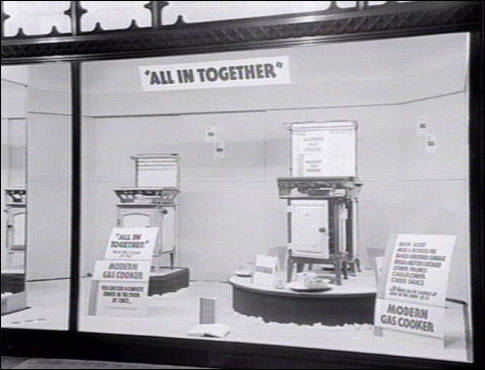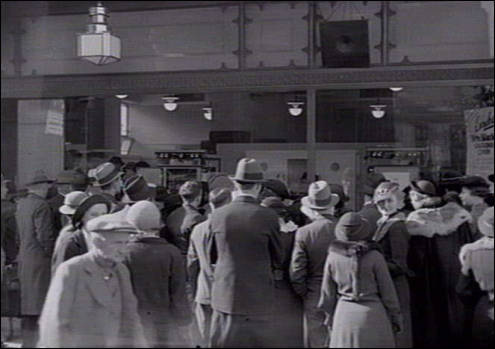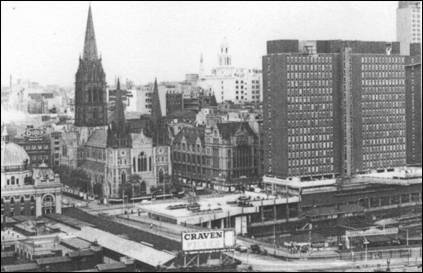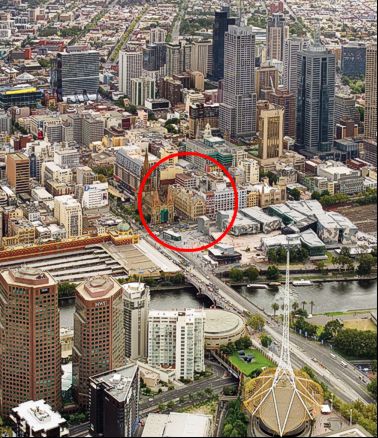|
You are here: The
Schloss >> History

A New Face
In the early 1930s, the Trustees of St Paul's Cathedral renewed the lease of the Flinders Street site to the Metropolitan Gas Company. This was done on the proviso that the building, which in places had fallen into a state of disrepair, was renovated. Despite the company experiencing difficult economic circumstances, brought upon by the Great Depression, it proceeded with the renovations and commissioned the architects W H & F B Tompkins to prepare plans for the building. The Tompkins' had designed some of Melbourne 's most prominent buildings, including two other Flinders Street landmarks, the Herald & Weekly Times building and the Commercial Travellers Association (now the Duxton Hotel).
Much of the work renovating the company's head office involved repairs to the façade. Its stone had deteriorated to such a degree that it was too damaged to repair, and the architects chose to reface the building with a synthetic stone, composed of ground Pyrmont sandstone mixed with white cement. The stone, it was claimed, matched the stone of the newly constructed spires of St Paul 's cathedral.

Part of the 1930s renovations to the building included the fitting of large display windows on the ground floor. The windows were used to show the company's gas appliances
(photograph reproduced from the Picture Collection, State Library of Victoria ).

Crowds gather outside the ground floor showroom in 1937 to see a demonstration of the Eureka New World gas cookers.
(photograph reproduced from the Picture Collection, State Library of Victoria ).
By the 1930s, in the vicinity of Flinders Street Station was a retail area of the city second only to Bourke Street , with large department stores including Craig Williamson, Mutual Stores, and located next door to this building Ball & Welch. Together they attracted thousands of customers daily to the area, in addition to the pedestrian traffic that walked along Cathedral Place from the station to other destinations in the city. As part of the renovations to the building an attempt was made to attract more shoppers to it. A new appliance showroom and demonstration kitchen was built on the ground floor and large plate glass windows fitted along Cathedral Place in order to display the company's gas appliances. The new showroom, touted as the most modern of its kind in the southern hemisphere, impressed local and overseas visitors alike.
The building remained the headquarters of the Metropolitan Gas Company, and its successor, the Gas & Fuel Corporation until 1967, when the head office was moved across Flinders Street to the Gas & Fuel towers. The former head office building was for many years used as retail premises for Clark Rubber. With the closure of the department stores in the area, the last being Ball & Welch, which closed its doors in the mid 1970s, the area fell into a decline as a retail strip.

In 1967 the head office, of what was then known as the Gas & Fuel Corporation, moved from 196 Flinders Street (centre) across the road to the new Princes Gate development (right) colloquially known as 'the Gas & Fuel towers'.
The towers were demolished in the late 1990s and the site is now Federation Square
(photograph reproduced from Proudley, Circle of Influence ).
The Gas & Fuel towers, initially a showpiece
for the corporation and the city itself, became regarded as an eyesore
in later years. Many also disliked it because it blocked the view
of St Paul 's Cathedral from the banks of the Yarra. In 1984 the
Gas & Fuel Corporation purchased its former head office and refurbished
it as offices, but sold the building in the 1990s when the State
Government privatised the organization. In 1998, Henkell Brothers,
Investment Managers, purchased the building, and today it is let
as premium office space. With Melbourne 's new civic and cultural
centre, Federation Square, and other developments in the area, 196
Flinders Street is leading the renaissance of the southern gateway
to the city.
References
- Ray Proudley, Circle of Influence. A History of the Gas Industry in Victoria , p 89.
- Philip Goad, Melbourne Architecture , p 51.
- Age , 6 February 1893.
- Argus , 11 October 1892.
- Star , 23 July 1934. Age , 21 November 1933.
- Ray Proudley, Circle of Influence. A History of the Gas Industry in Victoria , pp 169 & 171.
|
